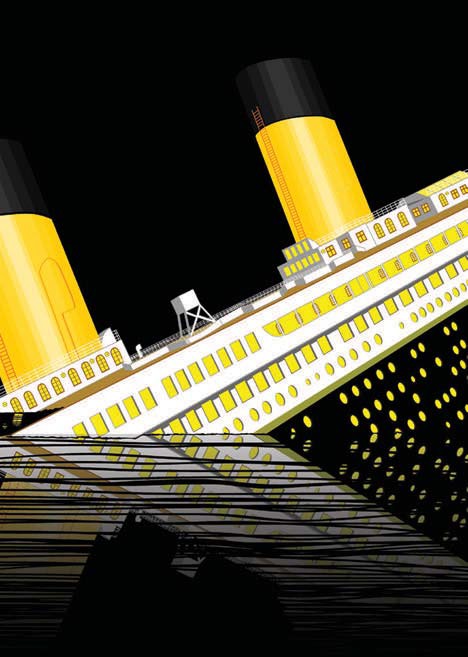Learning from Titanic
Evan Zabawski | TLT From the Editor April 2010
Reliability-centered maintenance uses history as an example.

Did poor rivets sink the Titanic? RCM teaches us how to identify seemingly inconsequential events and initiate corrections.
www.canstockphoto.com
April 15 is an important day in my home, and it has nothing to do with filing taxes. For the past 12 years this day has marked our annual viewing of James Cameron’s
Titanic, coinciding with the anniversary of the sinking in 1912. I have been a Titanophile since the mid-80s when I read Clive Cussler’s
Raise The Titanic! and eagerly picked up the December 1985 issue of
National Geographic, which analyzed the tragedy.
With each viewing I marvel at the filmmakers’ attention to detail (and note some errors), tremble at the sinking sequence and, by the end, wonder why it happened. Employing some basic RCM principles, it makes an interesting case study.
SAE JA1012, A Guide to RCM Standard, outlines the basic steps of applying RCM, but I always simplify it by using the analogy of acting like a five-year old simply asking “why” over and over until a definitive answer is found.
Asking why so many people died is easily answered by stating there weren’t enough lifeboats and the available boats were not filled quickly or to capacity. Why there weren’t enough lifeboats amounts to dealing with rules not designed for a ship of this magnitude. Why they weren’t filled quickly or to capacity is open to a little more debate, but basically speaking many passengers were oblivious to the true state of emergency, and the officers in charge were dubious that a full lifeboat could be lowered safely.
A more important question is why the boats were required, and that is obviously because the ship sank. Why it sank is too quickly answered with “because it hit an iceberg.” The boat sank because one too many of the watertight compartments filled, guaranteeing a loss of buoyancy.
From here we can branch off two ways: design and materials. Where design is a factor is in stating that too many compartments filled because the bulkheads did not go high enough, allowing water to spill in the next compartment as the bow dipped lower into the sea. We could also consider that the ship had a double bottom that did not extend up the sides of the vessel, which was corrected on the Titanic’s two sister ships and has been employed in ship design since the tragedy (a good example of application of RCM principles).
Materials played a big role, as indicated by the testing of pieces of hull recovered from the ocean floor. Arguments abound over the description of the hull plates being made from brittle steel, after some tests were thought to prove the hull steel was much more brittle than today’s hull steel but was later proven to be representative of ships from that era. When the iron rivets were tested, they were found to contain high concentrations of slag, which rendered them brittle and subpar for the era. A 1996 expedition to the wreck site using ground-penetrating radar determined there was no gash in her hull, but rather six narrow slits where bow plates appeared to have parted, solidifying the blame on the rivets.
Why the rivets were of poorer quality lies in the magnitude of constructing three such ships, each demanding nearly three million rivets apiece. The builder had to reach beyond its usual suppliers and include smaller forges with less experience. Compounding this problem was a shortage in labor as well, lending itself to hiring lower-skilled workers. Interestingly, other ship builders had switched from iron rivets requiring skillful hand riveting to superior steel rivets installed by machine with superior workmanship. The Titanic only employed steel rivets in its midsection, where stress was greatest, and iron rivets in the bow and stern.
The 14th Century proverb
For Want of a Nail reminds us that a seemingly inconsequential action can result in dire consequences, and RCM teaches us how to identify the nail. Are the rivets or a design flaw Titanic’s proverbial nail, or could failure to spot the iceberg in a timely fashion or failure to react accordingly be the true root cause?
If I keep asking why, I hope that one day I’ll figure out the answer.
 Evan Zabawski, CLS, is a training and consulting specialist for The Fluid Life Corp. in Edmonton, Alberta, Canada. You can reach him at evan@fluidlife.com
Evan Zabawski, CLS, is a training and consulting specialist for The Fluid Life Corp. in Edmonton, Alberta, Canada. You can reach him at evan@fluidlife.com.